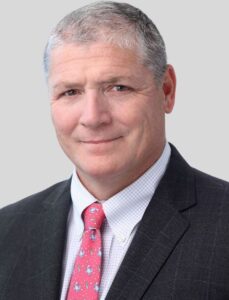Writer: Joey Garrand
 5 min read September 2022 — As New Jersey inches closer to 2050, the due date for the state’s 100% clean energy goal, energy companies in the state are making significant strides toward decarbonization. With Invest:, prominent energy leaders in the state shared insights into the progress their organization is making on the clean energy front.
5 min read September 2022 — As New Jersey inches closer to 2050, the due date for the state’s 100% clean energy goal, energy companies in the state are making significant strides toward decarbonization. With Invest:, prominent energy leaders in the state shared insights into the progress their organization is making on the clean energy front.
Mike Renna, President & CEO, South Jersey Industries
How is the decision to join forces with the Infrastructure Investment Fund (IIF) aligned with SJI’s decarbonization and clean energy initiatives?
We are extremely excited about the partnership with IIF because it will better enable us to execute on our clean energy and decarbonization initiatives in support of the environmental goals of our State and region. At present, we are going through the process of seeking our regulatory approvals, which we expect to wrap up by the end of 2022.
SJI is at the forefront of energy decarbonization with investments across our utility and non-utility entities and we are really looking forward to working with IIF in these efforts. Our vision aligns, our mission aligns, our priorities align. As a private company and with IIF’s long-term approach to utility and energy investments we will have efficient access to resources to modernize our critical infrastructure and maintain our high standard of customer service. Also important, once the transaction with IIF closes, SJI will remain a New Jersey-based company with our headquarters in Folsom, just as it has been for many decades. Maintaining the continuity of our leadership and management teams, doubling down on our commitment to supporting the communities we serve in New Jersey, and building an even stronger company with more career opportunities for our NJ-based workforce of over 1,100 employees were all integral components of the decision to enter into this strategic partnership SJI has been a trusted leader in the energy industry in New Jersey for over a century, and IIF’s support will serve to enhance the critically important role that we intend to play in the next generation of energy delivery in our state.
 Doug Mokoid, Region President, Atlantic City Electric & Delmarva Power
Doug Mokoid, Region President, Atlantic City Electric & Delmarva Power
What have been some of the key highlights for Atlantic City Electric over the last 12 months?
In September 2021, we launched a Climate Change Commitment in support of New Jersey’s clean energy and climate goals. This multipronged initiative focuses on actions the company is taking to reduce its operational impacts on the environment, and efforts with key external stakeholders and our customers to help them achieve their own environmental goals. As part of this effort, we have committed to purchasing 50% carbon-free electricity by 2025 and 100 percent clean energy by 2050, and we are committed to reducing emissions by 50%, as compared to a 2015 baseline by 2030, and to ultimately achieve net-zero by 2050 as part of the Path to Clean effort of our parent company, Exelon.
Among other efforts, we are electrifying 50% of the company’s passenger vehicles by 2030 and are taking steps to install LED lighting in all of our buildings by 2025. We have also launched a new energy marketplace to provide quick and easy access to energy-efficient products and new energy efficiency programs to provide a series of services and tools for limited- and moderate-income households to take control of their energy use and save money.
Joris Veldhoven, Commercial Director, Atlantic Shores Offshore Wind
How do you think that South Jersey’s reputation is changing as a business market?
The Atlantic Shores project will be the first project with full American-built foundations in the whole industry. It is a milestone for us and the state, and it can be done with our partners inside the region. Those are major steps and people notice it. As a result, it changes the reputation of South Jersey. The area used to be developed around the nuclear facility, but will now be used as a wind port, bringing a visionary industry into the region.
There are challenges and we often worry about them, especially regarding permitting and scheduling. The point is that things are moving forward and every month we are making progress to further strengthen this industry through new facilities that are being constructed in South Jersey. Additionally, I think the community colleges in the region have very productive collaborations with us. We are working to develop multiple studies with local colleges, for example, we are currently co-located on the Stockford campus. We have a lot to be positive about at the moment and we will keep playing our part.
 Michael Boches, CEO, Geoscape Solar
Michael Boches, CEO, Geoscape Solar
What would you say to detractors who question solar’s viability?
The technology is tried and true; there’s nothing speculative about the technology. The variability is tied to the weather. But these systems are on your property for 20, 30 years and the weather impact evens out. The payback in New Jersey and in states that dont have strong incentives is three to 10 years. I say solar is a risk free investment with a high potential return. It’s risk-free because the panels are there and will continue to produce electricity. As long as you’re in a building, you’re going to have an electric bill, so your guaranteed cost savings from the panels. Once the panels are paid back, you’re essentially getting free electricity for the remainder of your panels’ life.
We have customers replacing or renewing systems, not because the panels aren’t working anymore but because of the ongoing tax credits and incentives, and how much less panels cost compared to ten years ago. They’re looking at the economics, reupping for the new S-REC program with solar panels today producing twice as much energy as they did ten years ago, thinking, “We paid off those panels, but are we better off with the ones we have or getting some new ones?”
Kim Hanemann, President & COO, PSE&G
What are some PSE&G’s key highlights from the last year and how are priorities shaping up?
We’ve introduced our Powering Progress vision to power a future where our customers use less energy, and it’s cleaner, safer and delivered more reliably than ever. We are focused on that vision and have a five-year, $16 billion investment plan. One key element is our Clean Energy Future program, which includes a $1 billion investment in energy efficiency programs for residential and business customers. This program will allow customers to save money on their bills and use less power, while also being good for the environment. Another key element is a $700 million investment to install smart meters for our New Jersey electric customers. We already have around 85,000 smart meters, but we have 2.2 million more to install. We will be ramping up mass meter deployment this year. The last element of this program is a $160 million investment in the make-ready-work residential and public charging stations for electric vehicles.
When you look at the rest of our infrastructure investments, we are focusing on resilience and reliability with our Gas System Modernization Program. We are continuing to replace our exposed iron and unprotected steel natural gas mains. We are the largest single operator of cast-iron gas infrastructure in the country and have a little under 3,000 miles left to replace. We expect to reduce our methane emissions by 41% under that program. At the same time, as part of our Energy Strong program investments, we are making our electric and gas infrastructure more resilient to extreme weather events, to better withstand them and to better respond and restore customers as quickly as possible. We have raised and rebuilt 29 stations to get them out of flood zone areas, and Hurricane Ida proved the effectiveness of those investments. In September 2021, as the storm hit, we lost no power in any of those stations, and people could start their restoration processes quicker than what we experienced during Superstorm Sandy in 2012.

